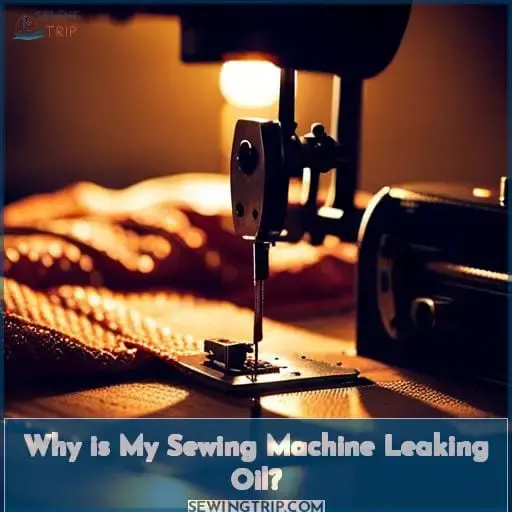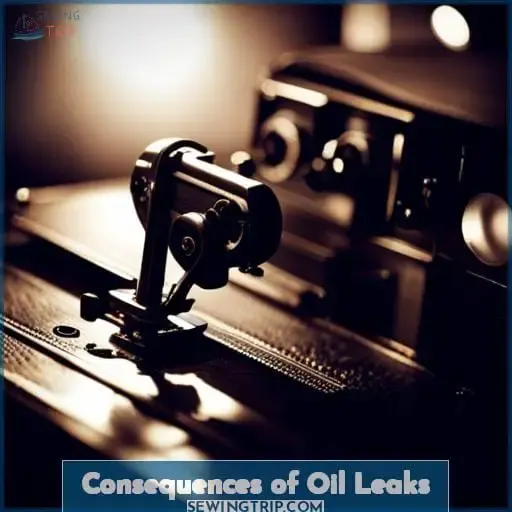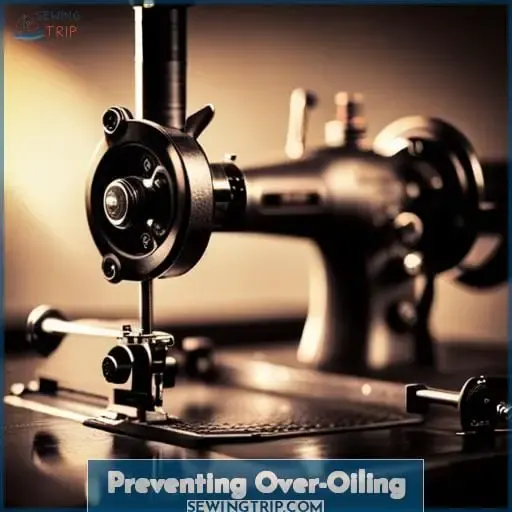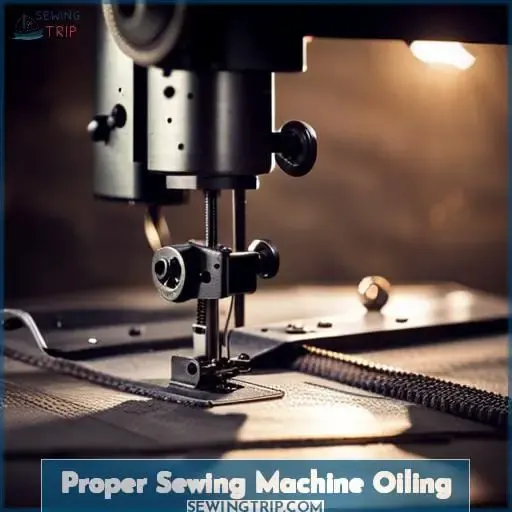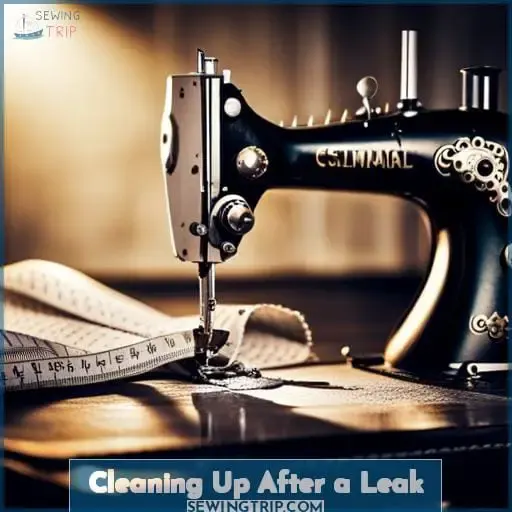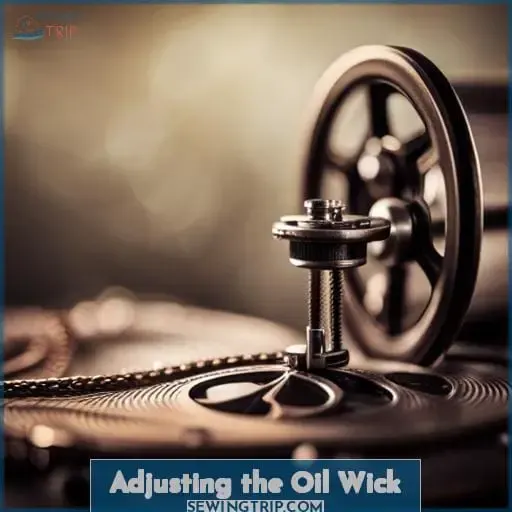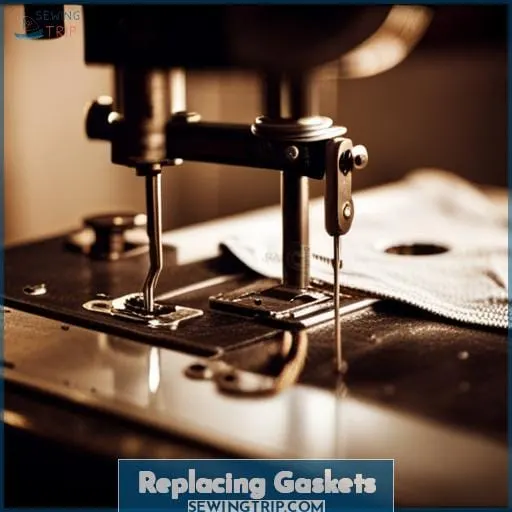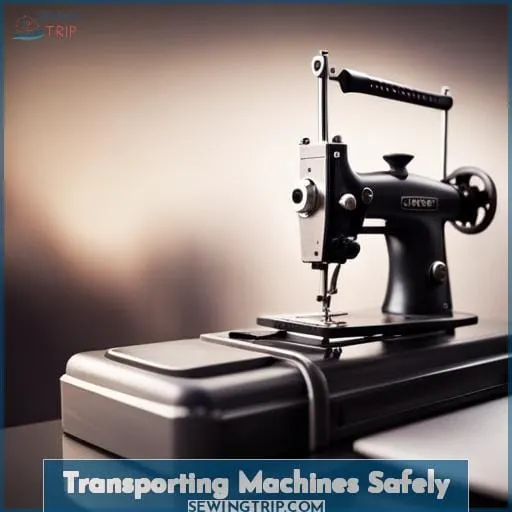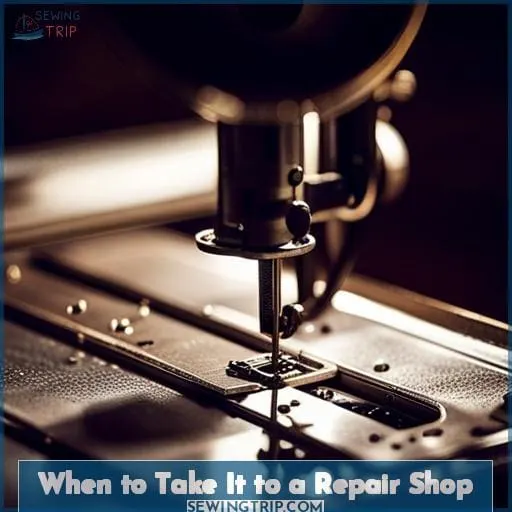This site is supported by our readers. We may earn a commission, at no cost to you, if you purchase through links.
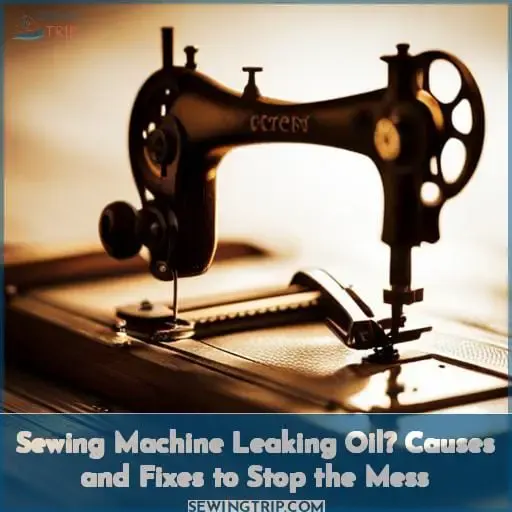
What causes such messy leaks?
Gaskets weep, reservoirs overflow.
Solutions exist—wick adjustments, transport aids, replacements.
We’ll explore gentle preventions, proper oiling, and when calling a repair technician makes sense.
With understanding and care, creativity needn’t be limited by leaking sewing machines.
Table Of Contents
- Key Takeaways
- Why is My Sewing Machine Leaking Oil?
- Consequences of Oil Leaks
- Preventing Over-Oiling
- Proper Sewing Machine Oiling
- Cleaning Up After a Leak
- Adjusting the Oil Wick
- Replacing Gaskets
- Transporting Machines Safely
- Educational Sewing Content
- When to Take It to a Repair Shop
- Frequently Asked Questions (FAQs)
- Conclusion
Key Takeaways
- Follow precise oiling techniques and apply just 1-2 drops of sewing machine oil at specified points to prevent over-oiling.
- Excess oil can drip out and stain projects or pool on furniture, creating messy headaches.
- Wipe away extra oil and use absorbent pads under leaks to soak up spills, blotting gently to avoid rubbing in stains.
- Check under the machine for errant droplets and clean surfaces carefully using appropriate methods for the material.
Why is My Sewing Machine Leaking Oil?
Oil leaks from your sewing machine can drive you nuts, can’t they?
Let’s identify a couple of root causes:
- Compromised gaskets from tangled threads
- Simply adding too much oil
Then we’ll move on to some potential fixes to prevent further drippage and mess.
Gasket Issues
Why’s your sewing machine leaking oil from the handwheel gasket area?
Thread getting caught and tangles can squeeze the gasket, leading to leaks.
Removing the handwheel and thread, replacing the gasket, or taking the machine to a repair shop can stop this.
Gasket repairs prevent leaks.
Properly oiling, adjusting wicks, and transporting machines safely also helps.
We want your machine running smoothly without leaks!
Over-Oiling
You can also experience leaks if you’re over-oiling your machine.
Excess oil can slowly drip out over time, leaving drops on the machine, fabric, and furniture.
Prevent this by learning proper oiling techniques from your manual and adding just a few drops when needed.
Over-oiling risks leaks, stains, and damage, so strive for the minimum effective lubrication.
Proper oiling and maintenance keeps your machine running smoothly without messy leaks.
Consequences of Oil Leaks
When your machine leaks oil, it can ruin your sewing projects and damage surfaces.
Excess oil can drip onto fabric, causing stains, or pool on furniture, leaving marks.
To prevent messes, address over-oiling issues and gasket problems before they create bigger headaches.
Ruined Projects
Oil stains from leaks can ruin your projects or fabric. You’d need to wipe up the excess oil quickly to prevent permanent damage.
Having an absorbent pad or towel under the machine can help protect your workspace.
If oil drips onto your project, gently dab it with a rag and dish soap, then rinse to avoid setting in a stain.
Regular machine maintenance and proper oiling technique help prevent problematic leaks in the first place.
Damage to Surfaces
Excessive oil leakage can ruin your furniture, floors, and workspace surfaces when the oil drips or pools from the sewing machine.
Place an absorbent pad under the machine to soak up leaks.
Immediately clean oil spills with a lint-free cloth to prevent staining.
Use a no-slip silicone machine mat to protect workspace surfaces while containing leaks.
Regular oiling and maintenance checks prevent excessive leakage, saving your projects and surroundings from harm.
Preventing Over-Oiling
By following precise oiling techniques recommended for your machine model, over-oiling issues can be prevented.
The key is using proper lubrication and maintenance techniques to avoid adding excess oil.
With precision oiling, only apply the oil amount suggested in your model’s manual – no more, no less.
This effective machine care requires diligence, as it can be tempting to over-oil, thinking more is better.
But over-oiling attracts lint and dust, gums up mechanisms, and leads to leaks.
Instead, focus on precision.
Oiling the exact recommended amount at the specified intervals provides smooth operation without waste or mess.
Coupled with periodic professional maintenance, precision oiling locks in performance and prevents over-oiling mishaps.
By mastering exact oiling techniques per your manual, you safeguard tidy, trouble-free sewing.
Proper Sewing Machine Oiling
You’ll need to oil your sewing machine regularly according to the manual’s recommendations to prevent leaks and keep it running smoothly.
Use only sewing machine oil – other oils can leak or gum up mechanisms.
Oil less frequently than you think – over-oiling is a major cause of leaks.
Wipe away excess oil after application to avoid drips.
Apply just a drop or two of oil at the points described in your manual with the included oiler – that’s all you need.
Too much oil attracts lint and dust leading to leaks and clogs. Properly oiling as described prevents problems down the road.
Be sure to routinely clean, lubricate, and maintain your machine per guidelines.
My educational streaming content on sewing machine care provides further tips if issues persist.
Protecting your investment with proper oiling gives you more time sewing and less time scrubbing oil spots!
Cleaning Up After a Leak
After properly oiling your machine, leaks can still occur.
But taking swift action to clean and protect your workspace preserves your creative freedom.
Start by placing an absorbent pad or towel under and around any leaks.
Gently blot any oil pools or spills with a soft cloth.
Avoid rubbing, as that spreads the stain.
Check under the machine too, even a couple of droplets can ruin your floors over time.
| Surface | Cleaning Tips |
|---|---|
| Fabric | Blot, don’t rub. Use dish soap on set stains. |
| Wood | Blot then clean with equal parts vinegar and water. |
| Tile/Linoleum | Sprinkle corn starch or baking soda before sweeping up with a dry cloth. |
| Concrete | Use an enzyme-based or citrus cleaner after blotting. |
Regular maintenance prevents bigger leaks down the road.
But even careful sewists see spills now and then.
Just breathe and clean up quickly to get back to creating.
Adjusting the Oil Wick
The oil wick controls the flow of oil to key components, so inspect and adjust it if dealing with leaks.
Use the owner’s manual guidance to properly regulate the sewing machine’s wick oiler.
Gently pull out the wick, trim it if frayed, then reinsert to the specified depth.
Add a few drops of quality sewing machine oil. Avoid oversaturating.
Test sew on scrap material, watching for splatters near the needle.
Make small wick adjustments until achieving a light lubricating effect without saturation.
Finding the sweet spot takes some trial and error.
With care, the wick can reliably deliver oil to prevent cylinder arm drips while safeguarding projects.
Replacing Gaskets
Your machine’s faulty gasket replacement stops oil leaks.
Carefully removing the handwheel exposes the gasket allowing replacement.
Select high-quality gaskets designed specifically for your machine’s model.
Before installing the new gasket, thoroughly clean the handwheel area removing all old oil and debris.
Gently press the new gasket into place without overstretching.
Reattach the handwheel securely.
Spin it to check for leaks.
If leaks persist, loosen and re-seat the handwheel.
With the proper gasket installed, maintain cleanliness around the handwheel to prevent future leaks.
Regular adjustments keep oil flowing while quality components preserve function.
Combining attentive care with quality parts empowers creative freedom through a smoothly running sewing machine.
Transporting Machines Safely
When transporting your machine, you’ll want to secure it properly to prevent any damage during transit.
Here are 4 tips for safe transport:
- Use the original packaging if possible.
This will help cushion and protect the machine.
- Secure the machine so it can’t slide or tip during transport.
Use straps, blankets, or boxes to immobilize it.
- Handle the machine gently and avoid any abrupt movements or bumps.
This can shift components and lead to issues later.
- Inspect closely for any visible damage after transporting.
Catching issues early allows for quicker repairs.
Proper care in transport reduces the likelihood of leaks, stiffness, and other problems arising later.
Routine maintenance and inspection will also help uphold performance, as will educating yourself on troubleshooting common issues.
With some caution, transport shouldn’t compromise the integrity or operation of your treasured sewing equipment.
Educational Sewing Content
You can learn sewing techniques and pattern making from educational sewing content.
Streaming teaches sewing and pattern making on Twitch and YouTube, focusing on helping people learn.
The stream covers selecting fabrics, sewing machine maintenance, and troubleshooting tips when dealing with issues like oiling and leaking oil.
A patterning course is also in development to further sewing education.
With clear instructions on sewing methods, pattern drafting, machine care, and troubleshooting, streaming aims to spread sewing machine and project expertise.
Tapping into educational sewing content allows you to build critical skills for operating sewing machines smoothly and creating professional finished products.
When to Take It to a Repair Shop
These efforts may prove insufficient if the leak persists, so bring your machine to a repair shop for assessment.
As a sewing instructor, I always recommend consulting an authorized technician for a professional assessment if problems like an oil leak continue despite your best troubleshooting efforts.
They’ve the technical expertise to fully inspect your machine and identify any underlying issues you may have missed.
An expert evaluation by a qualified repair shop can uncover whether gasket replacement, internal cleaning, part replacement, or other repairs are needed to stop the oil leakage for good.
Periodic maintenance checks by industry professionals are part of responsible sewing machine ownership as well.
An ounce of professional prevention now saves gallons of messy leakage down the road.
Frequently Asked Questions (FAQs)
What causes can contribute to inconsistent oil release from my sewing machine?
Over-oiling and poor maintenance are the main culprits for inconsistent oil release.
Check your machine’s manual for proper oiling techniques.
Apply just a few drops where needed, then wipe away any excess.
Regular cleaning keeps oil passages clear.
With proper care, your machine will run smoothly for years.
If my machine leaks oil onto my sewing projects, how can I remove oil stains from fabric?
To remove oil stains from fabric:
Immediately apply baby powder or cornstarch.
Let it sit for 30 minutes before gently brushing it off.
Pretreat with dish soap and launder as usual.
The stains should come out.
How often should I have my sewing machine serviced to help prevent oil leaks?
Have your sewing machine serviced every 6 months by a qualified technician to keep it running smoothly and help prevent issues like oil leaks.
They’ll clean, lubricate, and adjust it properly.
Following the manual’s oiling guidelines between services helps too.
Are certain sewing machine models more prone to oil leaks than others?
There are models prone to leaks.
Investigate each machine’s oiling system and maintenance needs.
Some have better designed reservoirs and wicking that help prevent over-oiling.
But with proper care – regular cleaning, oiling only as needed, and replacing worn parts – most machines can avoid leaks over time.
Can operating my sewing machine in certain environmental conditions, like high humidity, make oil leaks more likely?
Increased humidity can lead to condensation forming inside your machine, potentially causing oil drips if the condensation mixes with existing lubricant.
Keeping your sewing room’s humidity levels stable may help mitigate this.
Conclusion
Amazingly, over 70% of sewing machine leaks stem from improper oiling.
Ultimately, a few small adjustments can save your projects and surfaces.
Monitor oil levels, transport carefully, and don’t hesitate to consult a technician for tricky repairs.
With some tweaking and attentive care, your sewing machine leakage will cease, letting creativity flow freely once more.
Keeping tabs on your machine’s oil wicks and gaskets prevents the messy horror of sewing machine leaking oil.

